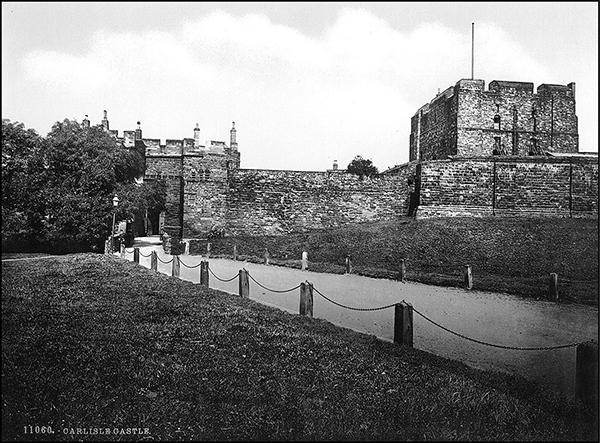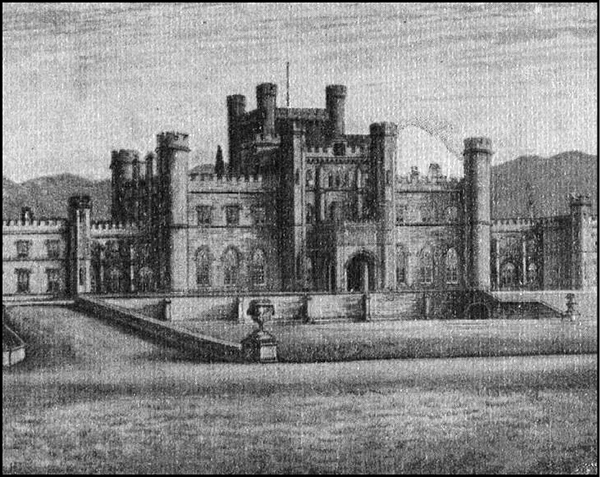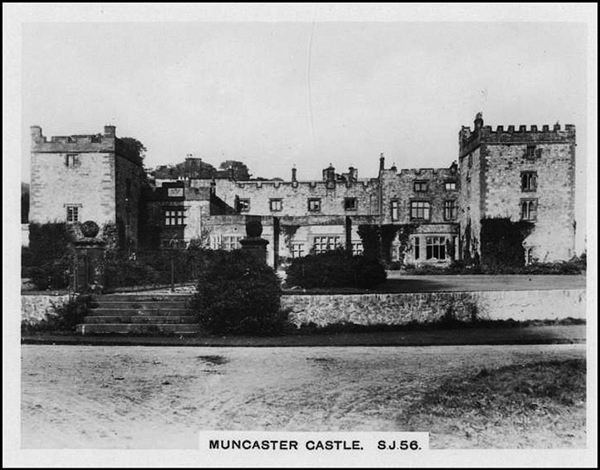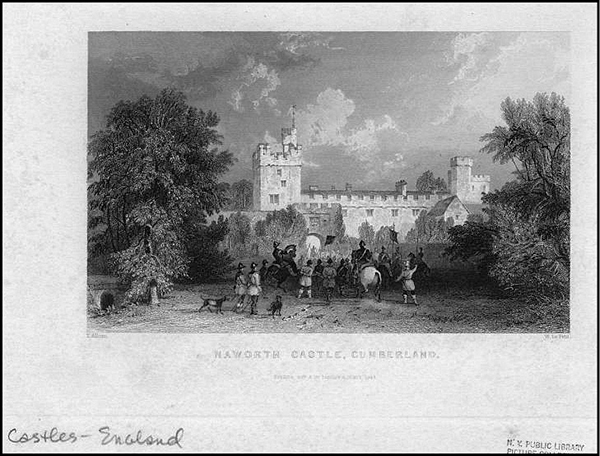Seven

Cumbria
http://askertoncastle.co.uk/history
Built around 1290 in the parish of Askerton in Cumbria, Askerton Castle was originally an unfortified manor. In the late fifteenth century, Thomas Lord Dacre built two crenellated towers on either end of the hall range, probably more so for increasing the living space than for any serious military or defensive purposes. A third tower may have been constructed on the north-west corner of the castle, but this is now long gone. It was renovated by architect Anthony Salvin in the 1850s and is now a Grade I listed building.
It is said to be haunted by the vengeful ghost of May Marye, who was murdered by a lover. Now she exacts revenge on the living by jumping on the backs of passing horses and terrifying their riders. It has been reported that she once engaged a rider in conversation, making him swear on his life that the topic of discussion would never be revealed to anyone.
Cumbria
www.english-heritage.org.uk/visit/places/carlisle-castle

Over 900 years old and the scene of many significant historical episodes in British history, Carlisle Castle is situated in Cumbria close to the ruins of Hadrian’s Wall. First built to keep the northern border of England secure from the threat of invasion from Scotland during the reign of William II of England, the son of William the Conqueror, it was constructed in 1093 when Cumberland (the original name for north and west Cumbria) was still considered a part of Scotland and it sits on the site of an old Roman fort.
Given the castle’s history it is not surprising that the majority of ghost sightings are of a military nature. For instance, the apparitions of two medieval soldiers have been reported on the top floor of the keep while a ghostly sentry sits on guard just inside the archway of the inner keep.
The ghost of King Stephen is said to lean against the wall in the upper keep next to the model of the City of Carlisle and the spirit of an old caretaker has been seen sitting in a chair near the old bell. Interestingly, there is a picture of him in life sitting at Queen Mary’s Table in the keep. As well, a black shadowy figure who wanders around in the inner keep has been reported by staff members and visitors alike.
A yeoman of an indeterminate era has been sighted walking up and down the pathway running in front of the cellblock toward the old Regimental Headquarters. One time it was reported that a caretaker doing his rounds met an apparently lost soldier on the stairs in Ypres block and when he told the soldier which way he needed to go he realized he was wearing the wrong uniform for the period.
Continuing with the military theme that seems to pervade this castle, it was reported that on one occasion, when locking Ypres block for the night, a Territorial Army Sergeant Major noticed that a light had been left on in the top-floor classroom. A corporal ran back upstairs and opened the classroom door to find it in darkness. Opening a window, he shouted down to the Sergeant Major that the light was off, only to be told that it wasn’t. The corporal apparently made a hasty retreat.
In Cumbria’s Military Museum, which is located within the castle grounds, several unexplained happenings have occurred including alarms being set off, even after an electrician replaced a faulty sensor, footsteps that can be heard upstairs when the place is empty, and on the back stairs a seemingly playful ghost pretends to push people down the stairs but then pulls them back as if playing a joke.
And, according to Richard Jones in his book Haunted Castles of Britain and Ireland: “In the 1830s during the construction of a parade ground and barracks, demolition work uncovered the skeleton of a lady bricked into one of the keep’s second-story walls. Three rings upon the bony digits of her fingers and remnants of her silk, tartan dress were evident. There were no clues to her identity, although there was considerable speculation that she may have been walled up alive. The opening of her tomb, however, appears to have roused her revenant, for in 1842 a sentry on guard duty in the keep challenged the figure of a woman who approached him in the early hours of one morning. As she ignored him, he shouted to rouse his fellow guardsmen. Then, raising his bayonet, he charged at the figure. Just as he reached her, the woman simply melted into thin air, whereupon the soldier fainted clean away. Although his comrades did manage to revive him, such was the shock to his system that, having told them what had happened, he promptly fell back and died.”
Cumbria
www.visitcumbria.com/pen/dacre-castle
A moated tower house that was constructed in the mid-fourteenth century, probably by Margaret Multon, Baroness Multon of Gilsland, as a form of defense against the threat of Scottish invasion and raids, it remained in the Dacre family until the seventeenth century. Renovated during the 1960s after periods of disrepair, the castle is now used as a private home although it does appear to have some otherworldly residents as well.
In the fifteenth century, Sir Guy Dacre fell in love with a girl called Eloise, the daughter of a French nobleman. She snubbed his advances, so he enlisted the help of his Italian tutor to help win her. Sadly though, the tutor had an affair with Eloise while Sir Guy was away fighting in Scotland. When he returned she agreed to marry him, although he was still unaware of this affair. Sir Guy once again left to fight in Scotland and entrusted the castle to a loyal friend, Lyulph, who soon learned of the affair. The lovers left the castle and moved to York, and Lyulph told Sir Guy about what he learned.
Sir Guy set off after them and brought Eloise back to his castle where he locked her in a dungeon. In the dungeon, she found her Italian lover chained to the wall, as Lyulph had previously captured him. When she tried to kiss him, his head rolled from his shoulders. Lyulph had cut off his head and then set him in the dungeon. Eloise was cruelly kept captive in the cell beside the rotting corpse of her lover and eventually went mad and then died. Not surprisingly, her ghost is now said to haunt the castle.
It is also said that the site of Dacre Castle was the meeting place of three kings in ancient times who met to arrange a peace treaty with the Vikings. Their regretful ghosts make an appearance at the castle to this day.
Cheshire
http://leasowecastle.com
Believed to have been built for Ferdinando Stanley, 5th Earl of Derby, in 1593, the castle became abandoned by 1700 and became known as Mockbeggar Hall, a term often used for a decorative but derelict building. In 1821 it was purchased by the Cust family and after 1826 it was used for some years as a hotel. Between 1911 and 1970, it operated as a railway convalescent home, and between 1974 and 1980 it was owned by the Wirral Borough Council. Reopening as a hotel in 1982, it is now a popular wedding venue with around fifty bedrooms.
There are a number of accounts of paranormal and ghostly activity at the castle including, many years ago, a family feud ending with a man and his child being imprisoned in one of the rooms. Rather than having to face reprisals, the man killed his son and then committed suicide. To this day many guests staying in this room have reported seeing the two ghostly figures.
Guests have also reported strange feelings and unexplained noises have also been heard on the stairs. Another ghostly presence is one who appeared after a fire destroyed one of the buildings. This phantom is said to be seen at waist level on the floor because, when it was rebuilt, the floor was raised to a different level. There are also other rumors regarding a number of secret passages running throughout the building and it is said that these passages are also haunted.
Cumbria
www.lowthercastle.org

A castellated mansion built by Robert Smirke for William Lowther, 1st Earl of Lonsdale between 1806 and 1814, Lowther Hall, for all its appearances, is nothing but a shell these days, although its previous grandeur is obvious to all those who visit. Sadly the estate and castle fell into disrepair when Hugh Lowther, the 5th Earl of Lonsdale, wasted the family fortune on his overly lavish lifestyle. As a result he was forced to abandon the castle and move into more modest accommodation and it was closed in 1937. During the Second World War it was used by a tank regiment, and by 1957 its roof was removed leaving the shell we see today.
It is reputed to be haunted by Sir James Lowther, who, while stuck in an unhappy arranged marriage, fell in love with a local farmer’s daughter. Sadly she died suddenly. Sir James kept the body, leaving it in bed and forbidding his servants to mention her. It is said that he would even dress her himself and seat her at the dining table with him. Finally she was placed in a coffin with a glass lid which he put in a cupboard so he could look at her, although after a while the body became so putrid it needed to be buried. The ghost of Sir James is said to reappear when the moon is full on the anniversary of his burial in the form of “Wicked Jemmy,” seated high on a carriage and driving maniacally through the parkland while frantically whipping his horses. Of the girl, no one knows?
More recently visitors to the castle have reported seeing a figure in one of the upper windows of the castle. However, as previously mentioned, the castle is an empty shell with no upper floors and no way of reaching the windows where the figure has been seen. Who she is is a complete mystery. Is it possible that Sir James’s tragic lost-love still watches for him over the years?
Cumbria
www.muncaster.co.uk

Originally known as Mulcaster or Molecaster (1190) and Mulecaster (1236), Muncaster Castle, which overlooks the Esk River, is suspected to lie on foundations dating back to Roman times. The Muncaster estate itself was granted to Alan de Penitone in 1208 along with the oldest parts of the castle including the Great Hall and the fourteenth-century pele tower, a watch tower fortification unique to the English Scottish border region. It is owned by the Pennington families who have lived there for at least 800 years.
In 1464, Sir John Pennington gave Henry VI shelter after he was found wandering aimlessly after the defeat at the Battle of Hexham. On his departure, Henry left his drinking bowl as a sign of gratitude telling Pennington that as long as the bowl remained unbroken then the Pennington family would continue to live and thrive in the castle. The bowl remains intact to this very day and is known as the “Luck of Muncaster.” And not only this, but as one would expect for such an ancient place, there are numerous reports of ghostly happenings within the castle walls.
The most haunted area is reputed to be the Tapestry Room. Visitors have reported the sound of a baby crying and a soft singing, which is believed to be a mother or a nanny soothing an upset child, as the room was previously used as a nursery. Other reports include disembodied footsteps, dragging sounds, rattling of the door handle in the middle of the night, the door opening, unexplained drops in temperature, frightening dark shadowy masses and the feeling of someone sitting down on the bed. As well, people often report an overwhelming feeling of someone else being in the room with them.
However, as haunted as this room appears to be, Muncaster Castle is more widely known for Tom Skelton, better known as Tom Fool. Tom was a jester at the castle until he died around 1600. Apparently he was a malicious and unpleasant character and would often direct people he didn’t like toward quicksand when they asked for directions. He was also believed to have played a part in the beheading of a local carpenter who had an affair with Sir Ferdinand Pennington’s daughter. The murder was thought to have been sanctioned by Pennington with Tom happy to assist so as to increase his status within castle social circles.
The current owners believe that Tom still resides within the great stone walls due to numerous strange happenings, especially those of a more sinister activity. Tom’s portrait still hangs in the castle and, although he is never seen, one tourist to the castle had a frightening experience while looking at the portrait, stating that she could plainly hear footsteps on a stone floor walking up behind her. When she turned to see who it was she was stunned to realize that she was alone. She also claimed that the footsteps were clearly on a stone floor even though the stairs and corridor are fully carpeted these days.
But whereas Tom Fool remains hidden from view, the castle also boasts a White Lady. The White Lady, also known as the Muncaster Boggle, is regularly seen. She is thought to be the spirit of Mary Bragg who was a housekeeper during the early 1800s and who was murdered. Her body was later found in the Esk River but in such a bad state from the eels in the river that finding a cause of death was impossible. She is now often seen wandering the castle gardens and local roads, a forlorn spirit forever destined to be alone.
The castle’s current owner, Patrick Gordon Duff Pennington, has ancestors who have been in residence since the early thirteenth century, noted in the 1995 television series Castle Ghosts of England that; “Sometimes when I open the doors, open the shutters in the mornings, people pull the doors out of my hands. The last curator used to see a Grey Lady walking up and down the passage outside our room.”
Not only that, he also added, “The tapestry room, people have slept in there and asked to be moved. They hear people crying and they feel cold. They think it’s a nasty place to be in and people who feel anything at all (are) not quite the same as when they went in.”
Apparently in 1993 a group of ghost investigators set up a number of scientific instruments designed to capture evidence of ghosts. At 10:40 p.m. they felt the temperature drop dramatically. A minute later a vase began shaking and a loud thud was heard followed by three raps on a wall. The investigators also noticed a movement outside the door. They concluded that the castle was inhabited by supernatural energies.
Cumbria
www.naworth.co.uk

Also known as “Naward”, Naworth Castle in Cumbria was the seat of the Barons Dacre and is thought to have been built in the late thirteenth century. It is a Grade I listed building with a square keep and bailey with its license to crenellate granted in 1335.
From 1939 to 1940 the castle was used by Rossall School in Lancashire due to the threat of German bombing. It is currently occupied by Philip Howard, brother of the thirteenth Earl of Carlisle.
The castle is said to be haunted by a White Lady, the spirit of a girl who was seduced by Lord Dacre without knowing his identity. She later became pregnant, and upon discovering Lord Dacres’s rank and social standing, she realized they could never be together as she was of a lower class. As a result she was heartbroken and threw herself into a stream and drowned. The body was later discovered by Lord Dacre and his betrothed, and the dead girl’s mother put a curse on Dacre, resulting in the death of him and his heirs. The ghost of the pregnant girl still haunts the castle, forever to remain alone and heartbroken.
Cumbria
www.visitcumbria.com/evnp/pendragon-castle
Standing above a bend in the River Eden, Pendragon Castle was built in the twelfth century by Ranulph de Meschines and has the remains of a Norman keep with the later addition of a fourteenth-century turret as well as some further seventeenth-century additions. According to legend, the castle was built by Uther Pendragon, father of King Arthur, who is said to have unsuccessfully tried to divert the river to provide its moat. However, as entwined in the Arthurian legend as it seems, there is no evidence of any pre-Norman occupation of the site.
Interestingly Uther Pendragon is said to have been buried under a large mound near Uffington in Oxfordshire and his legend is closely tied to Tintagel in Cornwall. Of course, these are simply legends, but it does make one wonder how they came about in the first place.
In 1342 and again in 1541, the castle was attacked by Scottish raiding parties. After the latter attack, it was seriously damaged and remained a ruin until it was acquired by Lady Anne Clifford, who rebuilt it in 1660. Her successor, Thomas, the Earl of Thanet, had little use for it and removed anything of value so by the 1770s much of it was in ruins.
Interestingly, Hugh de Morville, one of the knights who murdered Thomas Beckett in 1170, is one of the castles more notable owners, and it is said that his ghost haunts the ruins. As well, some believe the ghost of Uther Pendragon also remains as legend suggests that it was here that he and a hundred of his men were poisoned by the Saxon invaders.